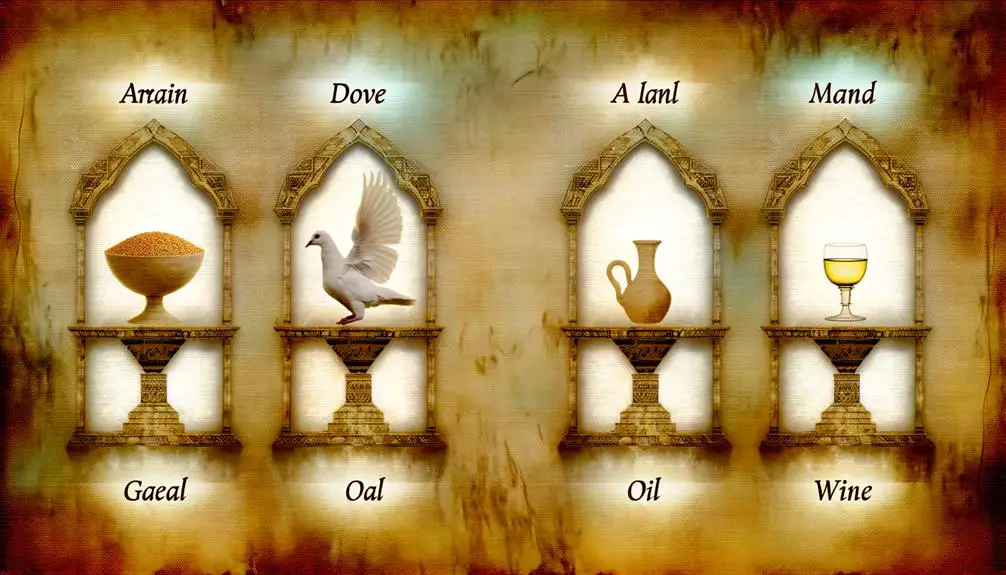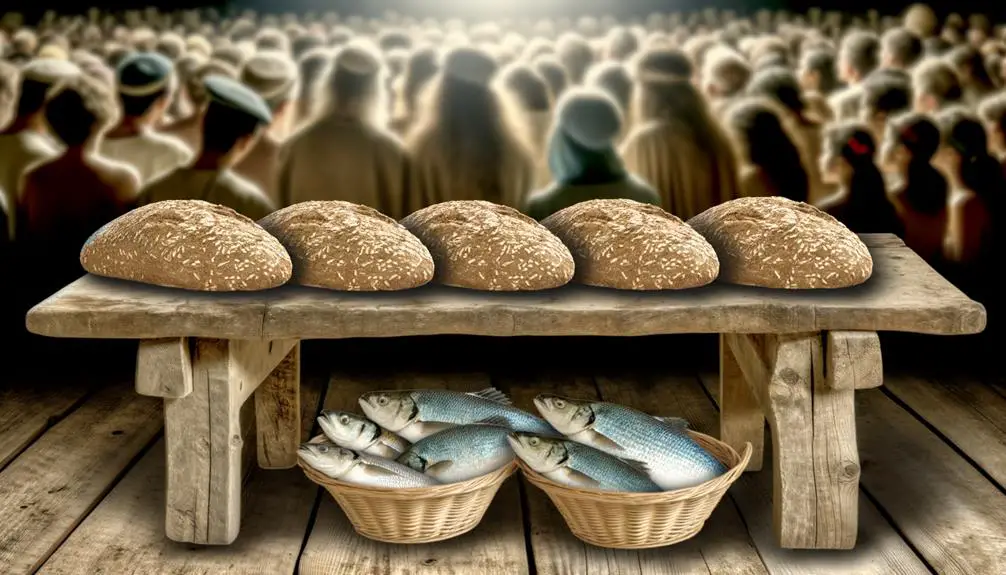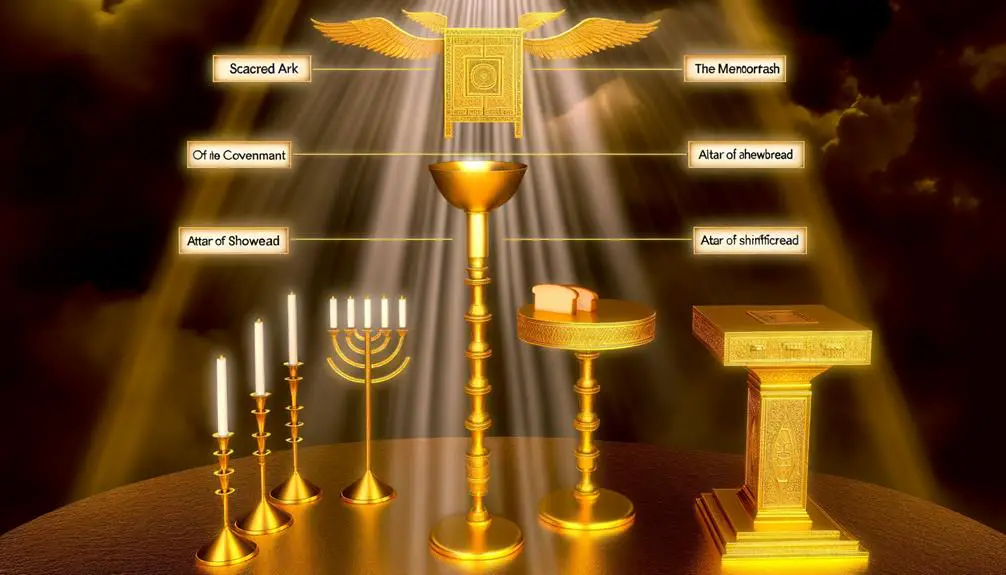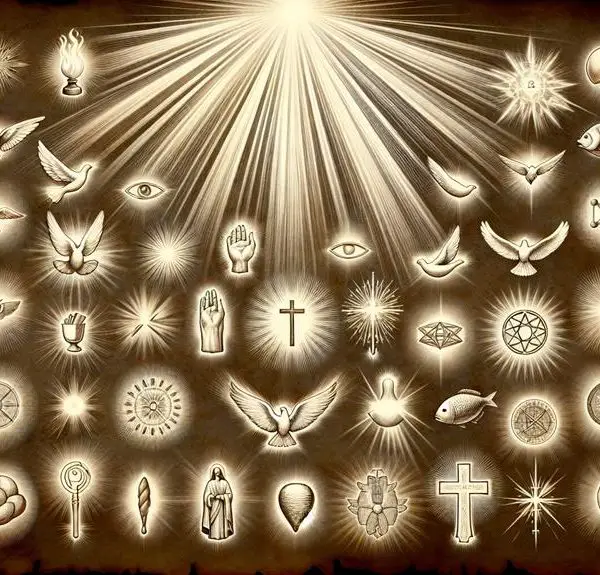From divine grace to atonement, explore how the number 5 weaves a mysterious thread through biblical narratives, revealing deeper meanings.

The Number 5 Meaning in the Bible
Like a hand with five fingers, the number 5 in the Bible stretches across scriptures, touching various aspects of faith and mysticism.
You'll find it woven into the fabric of the Pentateuch, marking the wounds of Christ, and even in the miracle of the five loaves feeding thousands.
This number isn't just a tally; it's a symbol ripe with meaning, hinting at grace, atonement, and divine favor.
As you explore its significance, you'll uncover layers of interpretation that could shift your understanding of biblical narratives.
What might the number 5 reveal about the deeper threads connecting these pivotal moments?
Key Takeaways
- The number 5 symbolizes God's grace and favor towards humanity in biblical texts.
- It embodies theological concepts like grace multiplication and divine harmony.
- Instances like the Pentateuch and Five Wounds of Christ highlight its profound significance.
- The number 5 guides personal conduct and emphasizes spiritual truths through biblical narratives.
The Pentateuch: Foundation of Faith

The Pentateuch, constituting the first five books of the Bible, lays the cornerstone of faith for millions, encapsulating the foundational laws, stories, and teachings that shape the core of Judeo-Christian beliefs. Central to this foundation is the concept of Mosaic authorship, which attributes these texts to Moses, a pivotal figure in both religious and historical contexts. This attribution not only lends the texts an authoritative weight but also situates them within a specific narrative and legal tradition that has profoundly influenced the development of Western legal and ethical systems.
You'll find that the Pentateuch is imbued with legal codes, such as the Ten Commandments, which serve as moral compasses for believers. These laws aren't merely historical artifacts; they're woven into the fabric of daily life, informing both personal conduct and community standards. The legal codes found within these texts underscore a transition from divine mandates to societal norms, embodying principles that resonate through ages.
Analyzing these texts, it's clear that the interplay between divine instruction and human action is a recurring theme. The Mosaic authorship asserts that these laws and narratives are divinely inspired, offering a direct link between the divine and the earthly realms. This connection is crucial for understanding the enduring significance of the Pentateuch in shaping moral and legal frameworks.
In essence, the Pentateuch's fusion of narrative, law, and divine commandment underpins a comprehensive worldview. Its teachings, attributed to Moses, haven't only guided individual behavior but have also shaped the collective identity and legal foundations of societies influenced by Judeo-Christian values.
Five Wounds of Christ

You'll find that the five wounds of Christ, incurred during his crucifixion, carry profound symbolic weight in biblical narrative and theology.
They represent not only the physical suffering endured but also serve as a cornerstone for understanding redemption through suffering.
This concept ties closely to the broader themes of sacrifice and salvation, inviting a deeper examination of its implications within Christian doctrine.
Symbolism in Crucifixion
In examining the crucifixion of Christ, one can't overlook the profound symbolism embodied in the five wounds He sustained, representing key aspects of Christian faith and theology.
This event, marked by Roman execution, wasn't merely a form of capital punishment but a manifestation of societal rejection. The wounds Christ bore—nails driven through both hands and feet, and a spear thrust into His side—aren't just physical injuries but profound symbols. They epitomize the ultimate sacrifice and the intense suffering endured.
This act of crucifixion, with its specific count of wounds, underlines a narrative deeply ingrained in Christian beliefs, highlighting the depth of Christ's passion and the magnitude of His sacrifice for humanity, transcending mere historical record to embody spiritual truths.
Redemption Through Suffering
Christ's five wounds, sustained during the crucifixion, serve as a profound emblem of redemption through suffering, encapsulating a cornerstone of Christian theology. This notion echoes through the annals of biblical narratives, notably in Job's trials, which prefigure the suffering-redemption paradigm. Prophetic imagery, rich in symbolism, further underscores this theme, portraying suffering as not merely an end but a transformative passage.
Aspect |
Significance |
|---|---|
Wounds |
Marks of sacrifice and redemption |
Job's Trials |
Testament to faith amid suffering |
Prophetic Imagery |
Foretells redemption through suffering |
Analyzing these elements reveals a complex tapestry where suffering is intricately tied to spiritual rebirth, a concept that's both sobering and uplifting, challenging you to view trials through a lens of eventual triumph.
The Five Offerings

Within the biblical context, the five offerings outlined in Leviticus serve as a cornerstone for understanding ancient Hebrew worship practices. These offerings, steeped in sacrificial significance and ritualistic practices, provide insight into the spiritual and communal life of the Israelites. They're not just ancient rites; they embody deeper theological meanings, reflecting themes of atonement, gratitude, and sanctification.
You'll find that each offering has a unique role within the covenant community. The Burnt Offering, for instance, represents total surrender to God's will, a profound act of worship where the entire animal is consumed by fire, symbolizing complete devotion. The Grain Offering complements this by acknowledging God's provision, using the fruits of the earth to express thankfulness without the shedding of blood.
The Peace Offering, on the other hand, signifies reconciliation and fellowship with God, often accompanying communal meals that strengthen the bonds within the community. It's a celebration of divine-human relationship, marked by shared joy and gratitude.
Sin and Guilt Offerings delve into the human condition, confronting moral and ritual impurities. They underscore the necessity of atonement and restitution, paving the way for forgiveness and restoration in one's relationship with God and the community. These offerings collectively highlight a pathway to holiness, emphasizing both individual and collective responsibility in maintaining divine order.
Understanding these offerings allows you to grasp the intricate balance of justice, mercy, and devotion that defines ancient Hebrew worship. They're not mere rituals but expressions of a deep, covenantal relationship with the Divine, reflecting a comprehensive view of human interaction with the sacred.
Five Loaves to Feed Thousands

Reflecting on the profound spiritual significance of the five offerings reveals a deeper understanding of divine provision, which is further exemplified through the miraculous feeding of thousands with just five loaves. This event isn't merely a historical account; it's a rich tapestry woven with miracle symbolism that speaks volumes about the nature of divine sustenance and the growth of the disciples' faith.
In the context of the biblical narrative, the five loaves that fed thousands underscore several pivotal themes:
- Divine Provision: The miracle illustrates that God's provision doesn't adhere to human limitations. The number five, symbolically tied to grace, underlines that it's by divine grace that needs are met beyond expectation.
- Faith in Action: The disciples' initial skepticism transitions to faith as they witness the multiplication of the loaves. This shift underscores the process of spiritual growth and the strengthening of faith through witnessing God's works.
- Miracle Symbolism: The act itself serves as a testament to Jesus' messianic identity and divine authority, reinforcing the belief in Him as the provider of spiritual nourishment.
- Community and Sharing: Implicit in the miracle is the theme of community. The sharing of bread not only physically fed the multitude but also fostered a sense of unity and shared purpose among those present.
- Sufficiency of Christ: The abundance of leftovers signifies that Christ's provision is more than sufficient to meet our needs, emphasizing the idea of overflowing grace and mercy.
This miracle, rich in symbolism, is a profound demonstration of God's ability to provide abundantly and the essential growth of the disciples' faith through witnessing such acts.
Symbolism of the Number 5

Delving into the symbolism of the number 5 in biblical texts reveals layers of meaning that transcend its simple numerical value. This digit isn't just a figure; it's a symbol rich with significance, representing concepts such as grace multiplication and divine harmony. When you explore the biblical narrative, you'll find that the number 5 frequently signifies God's grace and favor towards humanity. It's as if each occurrence of the number 5 is a reminder of the unearned blessings bestowed upon us.
Consider the Pentateuch, the first five books of the Bible, which are foundational to the faith and teachings of both Judaism and Christianity. These texts aren't only central to the religious doctrine but also symbolize the initial grace multiplication, providing a divine guide to living a life in harmony with God's will. This sets a precedent for the number's ongoing association with divine grace throughout the scriptures.
Moreover, the occurrences of 5 in the context of miracles and teachings often underscore the principle of divine harmony. It's about the balance and order that God brings into the world and into the lives of believers. The number 5, in these instances, acts as a symbol of the alignment between the divine and the earthly, highlighting the perfect interplay between God's will and the material world.
In this light, the number 5 in biblical texts isn't just a number. It's a profound symbol that encapsulates key theological concepts of grace multiplication and divine harmony, offering a deeper understanding of the spiritual narrative.
The Tabernacle's Five Components

Building on the symbolism of the number 5 in biblical narratives, the Tabernacle's five components further exemplify the intricate link between divine grace and earthly worship. This sacred architecture, designed with divine instructions, serves as a physical manifestation of God's presence among His people. It's not just a place of worship but a carefully structured environment, embodying the principles of construction and design that mirror the perfection and order of divine creation.
The Tabernacle was constructed according to specific principles, each component symbolizing aspects of spiritual truth and human interaction with the divine. Let's delve into the significance of its five key components:
- The Ark of the Covenant: Symbolizing God's covenant with His people, offering a tangible representation of His promise and presence.
- The Table of Showbread: Representing God's provision, reminding worshippers of their daily dependence on divine sustenance.
- The Golden Lampstand: Illuminating the space, this component symbolizes the light of God's truth guiding His people.
- The Altar of Incense: Signifying prayers and worship ascending to heaven, embodying the communication between God and His worshippers.
- The Bronze Altar: Where sacrifices were made, this element underscores the necessity of atonement and the seriousness of sin.
Through these components, you see how sacred architecture and construction principles in the Tabernacle not only created a space for worship but also conveyed deep spiritual truths. Each element, meticulously designed and placed, serves as a reminder of God's grace, his provisions, and the importance of a relationship with the divine.
Frequently Asked Questions
How Does the Number 5 Relate to the Concept of Grace in Biblical Theology Outside of the Explicitly Listed Instances?
You're exploring how grace multiplication and Pentecost significance tie into biblical theology, beyond explicit mentions. This inquiry requires digging into symbolic interpretations and theological frameworks.
Grace, often seen as God's unmerited favor, aligns with the concept of multiplication, suggesting an abundant, overflowing gift. Pentecost, marking the Holy Spirit's descent, symbolizes a new era of grace, emphasizing its transformative power.
Analyzing these connections offers deeper insights into the dynamics of grace in scripture.
Are There Any Lesser-Known Biblical Characters or Stories That Significantly Incorporate the Number 5, Not Covered in the Common Themes Mentioned?
You're diving into the depths of lesser-known narratives, searching for instances where five isn't just a number but a symbol. Consider David, who selected five stones before facing Goliath, a detail easily overlooked yet rich with implications.
It's a moment that mirrors the Pentateuch parallels, inviting a scholarly analysis. This subtle incorporation invites you to ponder its significance beyond the surface, adding layers to your understanding of biblical symbolism and narrative structure.
How Has the Interpretation or Significance of the Number 5 Evolved in Christian Thought and Theology From Early Christianity to the Present Day?
You're exploring how interpretations of numerical patterns, including the number 5, have evolved in Christian thought. Initially, early Christians might've seen it reflecting certain theological concepts.
Over centuries, as scholarly approaches to biblical texts advanced, the significance attributed to numbers, including 5, has been critically assessed.
Modern numerology within Christianity often attempts to find a balance between historical symbolism and contemporary spiritual insight, showing a nuanced evolution of thought from early Christianity to today.
In What Ways Has the Symbolism of the Number 5 Been Incorporated or Reflected in Christian Art, Architecture, or Literature Throughout History?
In the tapestry of Christian symbolism, you've seen the number 5 subtly woven through art and architecture, like whispers of a deeper truth. Five-petaled flowers and pentagonal designs aren't mere decorations but reflections of this number's spiritual significance.
They're found in stained glass, altarpieces, and church floor plans, serving as a bridge between the divine and the earthly. Analyzing these elements reveals how Christianity has visually encoded this number throughout history.
Can the Significance of the Number 5 Be Found in the Practices or Beliefs of Other Religions or Cultures, and How Does This Compare to Its Biblical Interpretation?
You'll find that numerology studies reveal the number 5 holds significance across various cultures and religions, not just in Christianity. Cultural parallels show it often symbolizes balance, harmony, and human life.
When you compare these interpretations, it's fascinating to see how they align or diverge from the biblical meaning of 5. Analyzing these connections gives you deeper insight into how universal concepts of balance and harmony are reflected in the number 5.
Conclusion
In your journey through the biblical landscape, you've uncovered the quintessence of the number 5, a symbol woven into the fabric of faith's foundation. From the Pentateuch's first strokes to the five wounds marking Christ's sacrifice, this numeral serves as a beacon, guiding believers through history's fog.
It's the bread and the balm, the question and the answer, encapsulating divine grace and human frailty. Through this exploration, you've stitched together a tapestry of understanding, revealing the intricate patterns of divine design.



Sign up